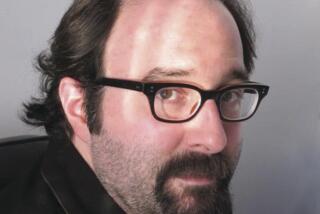VIDEO : The Watchdog Is on the Case : Movies on tape, disc and TV aren’t always the same as the theatrical versions. Ace videophile Tim Lucas knows where the missing pieces are.
- Share via
Don’t assume that the movie you rent on video or watch on television is the same version that played in theaters. From shortened running times and cropped images to deleted or alternate footage, it’s a crime what can happen in the transfer from film to video.
But videophiles can rest easy. Tim Lucas, the “video watchdog,” is on the case--armed with five VCRs (three VHS, one Beta and one multi-standard player) and one laser-disc player.
How do the TV and movie versions of “Amazon Women on the Moon” differ? How definitive is the “Definitive Collection” laser-disc edition of the “Star Wars” trilogy? How complete is the restored version of the 1932 classic “Dr. Jekyll and Mr. Hyde”?
The answers to these and other mysteries can be found in Video Watchdog magazine, bimonthly “perfectionist’s guide to fantastic video” that specializes in horror (domestic and foreign), science-fiction, cult and B-movies and European art films.
Lucas is editor and publisher of the 10,000-circulation magazine, which had its genesis in a column he wrote briefly for the now-defunct Video Times magazine. In 1985, Lucas decided he had enough material for his own magazine.
“I noticed that a lot of films were turning up on tape in forms that were new and unfamiliar,” he says. “But no one was out there taking notes and telling the public.”
*
Lucas has told his readers, for example, that the video of the 1974 British film “Frankenstein and the Monster From Hell” sports an R rating on the box but is in fact the “squeaky-clean” edited-for-TV version. One scene that does not show up on the video is one in which Dr. Frankenstein is forced to clamp an artery in his teeth while trying to reattach the monster’s hand during surgery.
Lucas also alerts videophiles about something that’s common on laser discs: Movies that were edited for an R rating in this country may show up on Japanese imports with the deleted footage. For example, John Landis’ “Innocent Blood” is “even gorier,” Lucas says, on the Japanese disc.
And, he says, the Japanese have something U.S. video companies have yet to offer--comparative editions of films. A “Godzilla” laser-disc boxed set contains the original Japanese film, the 1956 American version with the Raymond Burr inserts and goodies like original storyboards.
Video Watchdog also keeps readers up to date about bonus footage available only on video, such as the releases of “Star Trek--The Motion Picture” and “Dances With Wolves.”
According to Leonard Maltin’s “Movie and Video Guide,” “Star Trek’s” original running time was 132 minutes. The home video version is 143 minutes. A 240-minute “director’s cut” version of “Wolves” was released in August, 1993, as part of a “Collector’s Edition.” The theatrical release was 181 minutes.
Sometimes, a movie is actually shortened. Joe Dante’s reworked home video version of “Explorers” runs 107 minutes, instead of the 109-minute theatrical running time.
Who reads Video Watchdog?
“People who take films seriously and who are interested in the politics that go into perfecting a final theatrical release version,” Lucas says.
Lest that sound too highbrow, note Lucas’ excitement concerning a Japanese laser-disc version of the 1958 film “The Horror of Dracula” with Christopher Lee, which restores a staking sequence not contained on the American disc release (although it is included on the video). “That’s something our readers will pay $64 to see,” he says.
Those who wait to see a film until it is available on video may not know what they’re missing. For example, when the music rights are not secured for a video release, it can play havoc with the original score. The video version of “Blood Simple” robs the Coen brothers’ tense thriller of one of its most potent running jokes, replacing “The Same Old Song” by the Four Tops with a generic version of “I’m a Believer.”
Lucas said that he watches an average of about two films a day (his record is eight). Multiple viewings have attuned him to notice even the most split-second discrepancies.
“I watch the films so many times that when I see a version in which something doesn’t quite fit in, it really stands out,” he says.
Lucas also publishes the 392-page Video Watchdog Book and the annual 178-page Video Watchdog Special Edition, which reviews the year’s best releases, presents readers’ picks and includes a source directory on “where to find all this weird stuff.”
Being the “video watchdog” does have its peculiar rewards. It took a vigilant Lucas to bust Rhino Home Video after it spiced up a collection of horror films with intrusive rude remarks from TV’s buxom fright-film hostess Elvira. A chastened Rhino re-released the tapes without the offending commentary.
His readers seem just as fanatical. One Danish correspondent recently wrote that the Denmark video version of David Lynch’s “Blue Velvet” ended a second earlier than the original.
More to Read
The biggest entertainment stories
Get our big stories about Hollywood, film, television, music, arts, culture and more right in your inbox as soon as they publish.
You may occasionally receive promotional content from the Los Angeles Times.










